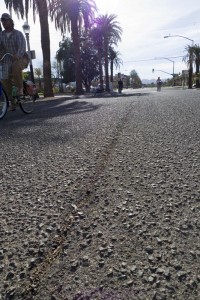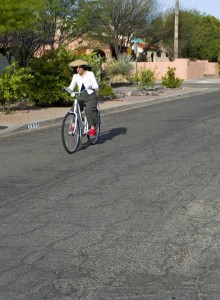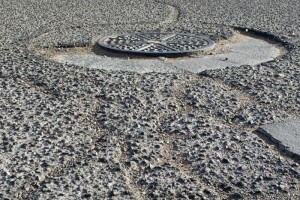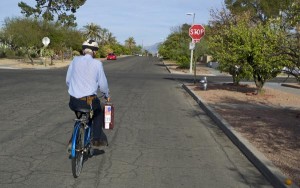
More cyclists traveled through the intersection of Third Street and Campbell Avenue than anywhere else in the region during the 2010 bike count. But despite its popularity, the route has a major flaw.
“It’s pretty bumpy,” cyclist Juliana Davies said while cruising toward campus on Third Street. “It is weathered and it needs to be smoothed.”
Davies said paving the street would increase safety.
“It would be nice because I could pay more attention to traffic than the potholes,” she said.
Jim Glock, the city’s transportation director, said he knows the pavement on Third Street is in pretty bad shape, but said the money to fix it just isn’t there.
“It’s tough,” Glock said. “It is not a good time for us with respect to pavement surfaces. Bike lanes, travel lanes, what have you, I’ve got a challenge across the city.”
The city’s bike and pedestrian program manager, Tom Thivener, said they are limited in what money they can use for fixing residential streets.
He said federal funding sources require the money to be spent on streets that move more traffic than residential streets and the RTA won’t pay for pavement fixes.

Thivener said he applied for a grant from Communities Putting Prevention to Work, but the city wasn’t awarded any money for the street.
He said he’d like to see a fix within the city that made streets like bike boulevards more of a priority.
“Right now we don’t have a mechanism to maintain the pavement on local streets,” Thivener said. “We really need to develop a new policy that does put money toward the local streets or at least puts them toward the prioritized local streets such as bike boulevards so that we can get pavement fixes and make it smoother out there.”
Thivener said places like Vancouver, British Columbia and Portland prioritize their bike routes.
“I know from my visit to Vancouver and Portland this past summer, they treat their bike boulevard-type streets more like collectors in their policy documents so that they get maintenance done on them more often,” he said.
Glock said there are two problems with the pavement. In the section between Campbell Avenue and Tucson Boulevard, the pavement has been washed away leaving bigger pebbles that make for a rough ride. The section between Tucson boulevard and Country Club Road is experiencing what Glock calls alligator cracking, which happens when water gets below the pavement and washes away the base layer that the asphalt sits on.

Glock said the fixes for each section differ, but the price ranges from $6.49 – $9.88 a square yard. The worst section of the street is one mile long and 30 feet wide, which means there are 17,600 square yards that would need to be repaired. The price would range from $114,000 to $174,000 to fix the street from Campbell Avenue to Country Club Road.
Glock said his maintenance budget has gone from $35 million to $25 million, so neighborhood street maintenance isn’t an option.
“Right now we are really not focusing too much on what technique would be better than another because we don’t have money to try any of them at this point,” Glock said.
Cyclists have discussed starting a fund to help pay for repaving the street. That is something Glock said could help. He said the city council had told him he can accept donations for specific projects, but in the interim he suggests picking which bike you ride wisely.

“I guess all I can offer is for folks to pick the appropriate bicycle for the pavement conditions they will be facing,” Glock said. “If you are planning a ride on our newly paved streets or on streets that are in good shape then get your graphite 130 pound psi tires out there and enjoy yourself. If you are on these rougher streets it might be time to get the mountain bike out with your suspension.”

This diversion of attention between surface conditions and traffic is Tucson’s worst problem. One or the other will get you. The recession provides a convenient excuse du jour, but we’ve suffered these streets for the past 25-30 years.
Riding a suspension bike would be more comfortable, but won’t save you from an incident. Cyclists, along with everyone else, have been contrbuting to the city for services all along. This thing that we’re freeloaders and must pay more for using less is giving me a rash.
Yet another advantage to riding a carefree beater MTB – not even noticing 3rd as being rough.
I know this doesn’t fix anything long term, but it seems like just rolling down the high spots where the cracks buckle upward would go a long way toward cheaply making 3rd a lot smoother until the money can be found to do it right. How much would it cost to just drive a roller up and down 3rd a few times?
Good coverage of how the Old Pueblo came to have the first municipal-sanctioned (wink-wink) mountain bike route on level terrain! That in itself should earn platinum status in the novelty category.
Meanwhile, they want expand bike routes and mitigation to other areas such as off Grant.
Seriously, these people are in danger of overextending themselves, 3rd St being the canary…
Seems easy to tell people to ride a different bike, but I can’t ever imagine the city transportation director telling drivers to drive a different car for dangerous streets.
This is a slap in the face.
Speaking as someone who hails from Pittsburgh, which is located in a state that’s long been known for its crummy road surfaces, permit me to add a bit of perspective. And that is that I’ve seen much worse.
However, even in pot-holey Pennsylvania, crummy road surfaces can become a major political issue. Remember Dick Thornburgh? Before he became Reagan’s attorney general, he was governor of PA.
One of his gubernatorial campaign platform’s hottest topics was fixing the state’s roads. Voters in the Keystone State went for it, and guess what? The Thornburgh administration embarked on a major road-fixing effort. The results were noticeable, even in Western PA, which has long been a mecca for potholes.
It’s as simple as attending to the specific roads problems that different regions have. Here they build a road, it’s nice for five years, then stays lousy for the next 35-40 years. I’ve wondered if painting the bike lanes white would slow down the heat effect on expansion cracks and wonder if it’s ever been tested anywhere.
Kayaking Ohiopyle repeatedly twenty years ago was a total blast, but the crazy roads to get there…well, kinda bring your Deliverance thing-the hills and runoff, the coal trucks, the 84 Lumber trucks. Strange natives but not dangerous.
Last year an old friend combined working on barges there with bike and rail touring on days off.
I ride this daily to work and it has gotten really bad. Every once in a while I’ll take Broadway instead so I can enjoy the smooth as glass ride. I’ve also been hit by a truck on Broadway when it made a right hook across the bike lane with no turn signal. I fear that not maintaining the bike routes discourages their use and pushes cyclists out onto more dangerous roads.